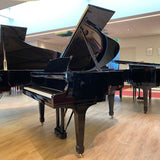Steinway & Sons O-180 vleugel (1940)
| Length (cm) | 180 |
| Width (cm) | 150 |
| Serial Number | 294258 |
| Year of construction/year of restoration | 1940 |
| Branch | Noordwijk |
Listen, Watch and Compare:
This grand piano was largely restored a number of years ago, including a completely new stringing. We sprayed the wing in a completely new black high-gloss.
Heinrich Engelhard Steinweg, the founder of Steinway & Sons, was born on 17/02/1797 in Wolfshagen im Harz, now Langelsheim, Lower Saxony (Germany) and died on 07/02/1871 in New York (USA). He initially settled in Seesen as a furniture and instrument maker. He had had a horrible childhood. Napoleon's armies left a trail of destruction in Germany at the time. The Steinweg's house burned down and several of Heinrich's brothers died. As a result of an accident, he later lost his father and other brothers, leaving him, the only survivor, orphaned at the age of 15.
HEY. Steinweg built his first table piano around 1825 and in 1850 he emigrated with his family, with the exception of his eldest son C.F. Theodor Steinweg (1825-1889), to America. C.F. Theodor Steinweg continued his father's business.
After an adjustment period in America, Henry Steinway (H.E. Steinweg) founded Steinway & Sons in 1853 together with his sons Henry Jr. (Heinrich, 1831-1865) and Charles (Karl, 1829-1865). William (Wilhelm, 1835-1896) and Albert (1840-1877) also joined later.
Due to the American Civil War (1861 to 1865), the Steinway Hall (center for arts and culture) was not opened until 1866. Piano sales then picked up considerably, partly because all concertgoers had to walk through the store before entering the concert hall. Steinway Hall had to close in 1890 because its function as a center for arts and culture was taken over by Carnegie Hall.
Many of Steinway's important technical ideas emerged from the intensive contact between C.F. Theodor Steinweg (Germany) and Henry (jr) Steinway (America). The first patent was granted to Steinway & Sons in 1857 and more than 125 more would follow since then, including the cross-string system used in grand pianos (1859), the sturdier cast iron frame and the duplex scale (1872), in which the sounding part of the string is supplemented with the (uniquely resounding) part of the string between the bridge and the attachment pins.
This provides a richer overtone ratio in the sound.
In 1865 Henry Jr. and Charles died, after which C.F. Theodor Steinweg (engineering) gave up his company in Germany to help his father (H.E. Steinweg / Henry Steinway Sr.), William (commerce) and Albert.
In 1880, Theodore and William began building a new Steinway factory in a rented building in Hamburg. A few years later they continued in their own factory building, which was soon expanded with several branches. Theodore died in Braunschweig in 1889.
Steinway was doing well until the stock market crash of 1929, but then sales collapsed. In the second half of the 1930s, Steinway started producing smaller instruments, after which things improved somewhat.
In 1941, the factory in Hamburg was seized as an enemy object, after which it had to contribute to the war industry. In 1943 the factory burned down completely as a result of a bombing. After 1948, production in Hamburg started again, but things continued to struggle in New York.
In 1972, the (until then) family business was sold to CBS-Columbia, which sold it again in 1985 to an investor group from Boston who then founded 'Steinway Musical Properties'.
This was sold to Conn-Selmer in 1995; he changes the name to ''Steinway Musical Instruments'. Since 1996, the company has been listed on the New York Stock Exchange under the name LVB (Ludwig van Beethoven). On September 18, 2013, LVB was acquired by hedge fund Paulson & Company, after which it was delisted again.














